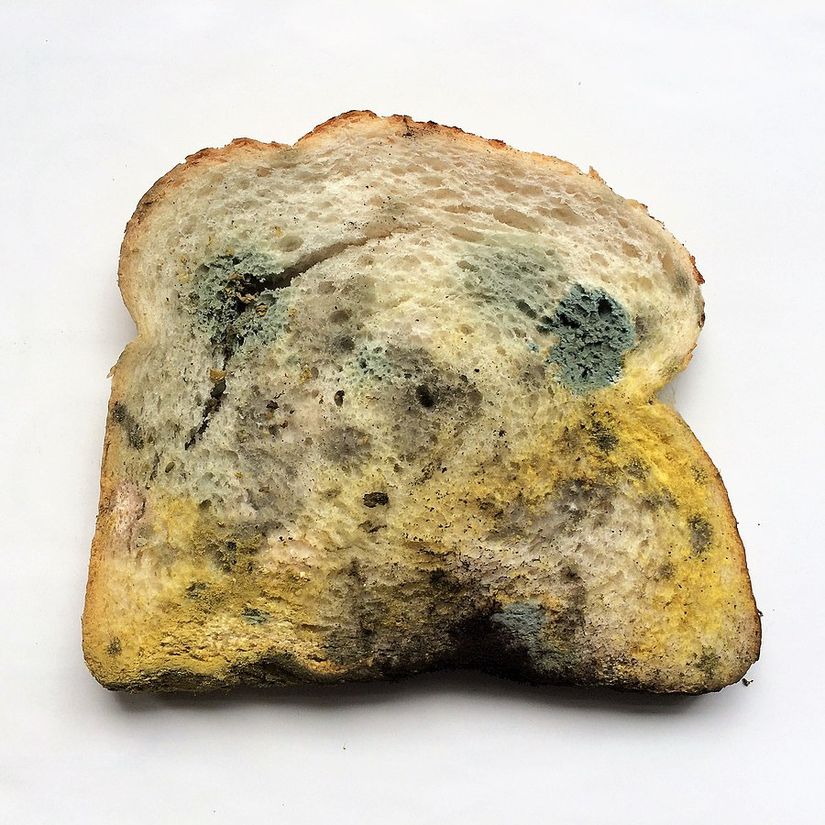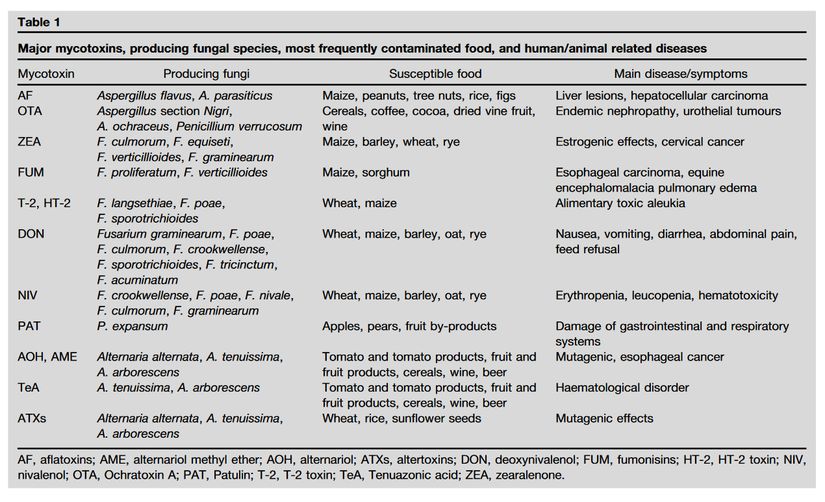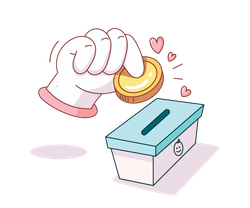After Cutting off the Moldy Parts, Is It Safe to Eat Moldy Cheese, Bread, and/or Fruits?

- Blog Yazısı
We have all been there. We pull out a block of our favorite cheese and some green mold is growing on a corner of it. What do you do? Some people simply toss it and others cut it off and enjoy their meal. But, what does the science and health experts say you should do? Let's find out.
Mold Basics
There are many things going on behind the white to yellow to green colored mold colonies that may grow on the surface of your bread. Mold is actually a type of fungus that uses organic matter (such as your food) as a way to sustain themselves. Mold grows as multicellular filaments called hyphae.

When we see the fuzzy growth parts of mold we are actually seeing the mold creating branches off of its hyphae to reach the surface to begin the process of releasing its germ cells also called conidia. These condidia are microscopic spores that the mold releases into the environment in order to reproduce. One can easily find fungi (plural form of fungus) spores in the air, surfaces in the kitchen, including the refrigerator, and soil due to the estimated 2.2 to 3.8 million species of fungus that are estimated to exist in our World and the majority of which release spores.[1] Currently, there are approximately 120,000 accepted and identified species of fungus and of those thousands are types of molds.

Therefore, the mold that you can see on the surface of your peach is only part of the picture. The hypae that the mold is branching out from are so thin that the naked eye cannot observe it. So, even if you remove the branches that have reached the surface, "the mold" the main branches of the fungus will remain. So, if you are cutting off the visible mold you are doing nothing about the rest of the mold living inside of the food and other substances the mold could have created.
Reality of Mold Health Concerns
There are a few reasons why we do not hear many people suffering from mold related health consequences on a daily basis. Even from people who choose to simply cut away the visible mold on their spoiled food.
- The first reason is related to individuals being repulsed by the sight of mold and throwing the food away and not taking any risk. This is what scientists call food disgust, which is a profoundly ingrained protection mechanism that helps us avoid risk in consuming hard-to-detect substances that can be harmful or hazardous to our health.[3], [4]
- Another reason is that mold may not be as harmful as many people believe and our immune systems help protect us. Most molds are harmless, but some are dangerous, in fact very dangerous. Depending on the type of mold they may produce one or several types of natural products also called secondary metabolites.[5] The benefits of these secondary products are still being studied in mold, but they are of significant interest to humans for their applications in the fields of agriculture, medicine, and industry.[5], [6] These natural products can be beneficial to humans, such as the antibodies produced by penicillin or harmful, such as mycotoxins. The mold often starts to create these natural products after their initial growth phase is finished and it is ready to reproduce by creating spores. Basically, this means the fuzzy growth of mold that you see on your food is the fungus getting ready to reproduce and the presence of these harmful/beneficial natural products (secondary metabolites) may or may not already be present in your food. So, when a person eats food that has had mold cut off they may be consuming a non-toxic mold that does not produce harmful secondary metabolites like mycotoxins. So, the mold will not make them ill. They may also be consuming a toxic mold that has simply not produced harmful secondary metabolites yet (the conditions may have to be right for their production) and will not become ill. However, they also risk eating a mold that has been able to create mycotoxins or worst aflatoxin and they become ill.[2] This means that the individuals who choose to consume moldy foods are taking the chance each time they do consume it. Sometimes they are luckily and other times they may experience a reaction and become ill. Acute symptoms include:
- The last potential reason is how long it can take for the detrimental health effects to come about from consuming mold and its harmful secondary metabolites and the link to mold may not be as easily apparent. For example, we mentioned aflatoxins as a health risk. In the 1960s these substances were discovered for the first time when tens of thousands of turkeys, pheasants, and ducklings, were dying in the United Kingdom. The mortality rate was extremely high among turkeys. The seemingly fine turkeys would drop dead
However, according to Nadine Shaw, a technical information specialist at the U.S. Department of Agriculture says;
“Most molds are harmless but some are dangerous. Some molds contain mycotoxins, which are poisonous substances that can cause allergic reactions or respiratory problems. One, in particular, called aflatoxin, has been known to cause cancer.”

Common Molds on Food
Mold identification is extremely hard to do and you
Mycotoxins are usually found in fungi that grow on grains and nuts. However, it also can be seen in fungi that grow in grape juice, celery, apples, and other fruits and vegetables.
Aflatoxin which is notorious for being a carcinogenic mycotoxin usually can be found in fungi species that grow in corn and peanut products. Probably, for this reason, our elders know that molds of some foods are harmless and they don’t find it wrong to eat them. Humans used to figure out whether things are harmful or not by trial and error before modern science.
Cheese and Fungi
What about cheeses? The first thing that comes to mind is going to be that question. Because moldy cheese has a huge industry right now, let alone health concerns! On that, the globally famous Mayo Clinic has a clear answer: If soft cheeses like cottage cheese, cream cheese, ricotta cheese, and sliced, milled, ground, granulated ones have mold on them; they shouldn’t be eaten at all.
Aslında maddi destek istememizin nedeni çok basit: Çünkü Evrim Ağacı, bizim tek mesleğimiz, tek gelir kaynağımız. Birçoklarının aksine bizler, sosyal medyada gördüğünüz makale ve videolarımızı hobi olarak, mesleğimizden arta kalan zamanlarda yapmıyoruz. Dolayısıyla bu işi sürdürebilmek için gelir elde etmemiz gerekiyor.
Bunda elbette ki hiçbir sakınca yok; kimin, ne şartlar altında yayın yapmayı seçtiği büyük oranda bir tercih meselesi. Ne var ki biz, eğer ana mesleklerimizi icra edecek olursak (yani kendi mesleğimiz doğrultusunda bir iş sahibi olursak) Evrim Ağacı'na zaman ayıramayacağımızı, ayakta tutamayacağımızı biliyoruz. Çünkü az sonra detaylarını vereceğimiz üzere, Evrim Ağacı sosyal medyada denk geldiğiniz makale ve videolardan çok daha büyük, kapsamlı ve aşırı zaman alan bir bilim platformu projesi. Bu nedenle bizler, meslek olarak Evrim Ağacı'nı seçtik.
Eğer hem Evrim Ağacı'ndan hayatımızı idame ettirecek, mesleklerimizi bırakmayı en azından kısmen meşrulaştıracak ve mantıklı kılacak kadar bir gelir kaynağı elde edemezsek, mecburen Evrim Ağacı'nı bırakıp, kendi mesleklerimize döneceğiz. Ama bunu istemiyoruz ve bu nedenle didiniyoruz.
Mold can easily spread inside these types of cheeses without being visible and highly dangerous bacteria species such as listeria, salmonella, brucella, E. coli can easily reproduce inside the moldy cheese.
If cheese is semi-soft or solid, mold can’t spread to the whole of the cheese and you can eat the rest of it after cutting off the mold. Cheddar, Colby, Parmesan, Swiss cheeses can be considered in this category. You should cut off at least one inch of cheese around the moldy part while carving it out, the rest of it is yours. But keep in mind that if you keep close the knife and the cheese without cleaning your knife, you can contaminate your cheese with fungi again.
However, not every mold fungus on cheese is harmful. Some molds are being used as raw materials for the production of some cheeses such as Brie Cheese, Camembert, Stilton, Roquefort, Blue Cheese, Asiago Cheese, Gruyere Cheese, and Gorgonzola Cheese. In Turkey’s different regions, there are also lots of cheese types that have the same basis of production as European ones such as Divli Cheese, Kerti Cheese, etc. Since these cheeses are being produced by fungi, they can be consumed when they get moldy too. In terms of health, there is no harm in consuming cheese that is sold as “moldy” as long as it’s been bought from reliable manufacturers. But eating a moldy cheese that shouldn’t have mold on it means you’re taking the risk that we’ve covered at the beginning. Moreover, like in some of the villages in Turkey, researchers proved that even moldy cheeses can be unhealthy when they’ve been produced in unhygienic conditions.
- 1
- 0
- 0
- 0
- 0
- 0
- 0
- 0
- 0
- 0
- 0
- 0
- ^ D. L. Hawksworth, et al. (2017). Fungal Diversity Revisited: 2.2 To 3.8 Million Species. Microbiology Spectrum. doi: 10.1128/microbiolspec.FUNK-0052-2016. | Arşiv Bağlantısı
- ^ A. M. Calvo, et al. (2020). Relationship Between Secondary Metabolism And Fungal Development. Microbiology and Molecular Biology Reviews, sf: 447-459. doi: 10.1128/MMBR.66.3.447-459.2002. | Arşiv Bağlantısı
- ^ C. Hartmann, et al. (2018). Development And Validation Of The Food Disgust Scale. Food Quality and Preference, sf: 38-50. doi: 10.1016/j.foodqual.2017.07.013. | Arşiv Bağlantısı
- ^ A. Patriarca, et al. (2017). Prevalence Of Mycotoxins In Foods And Decontamination. Current Opinion in Food Science, sf: 50-60. doi: 10.1016/j.cofs.2017.01.011. | Arşiv Bağlantısı
- ^ a b J. D. Bu'Lock. (1961). Intermediary Metabolism And Antibiotic Synthesis. Academic Press, sf: 293-342. doi: 10.1016/S0065-2164(08)70514-8. | Arşiv Bağlantısı
- ^ A. Egolf, et al. (2019). When Evolution Works Against The Future: Disgust's Contributions To The Acceptance Of New Food Technologies. Risk Analysis, sf: 1546-1559. doi: 10.1111/risa.13279. | Arşiv Bağlantısı
Evrim Ağacı'na her ay sadece 1 kahve ısmarlayarak destek olmak ister misiniz?
Şu iki siteden birini kullanarak şimdi destek olabilirsiniz:
kreosus.com/evrimagaci | patreon.com/evrimagaci
Çıktı Bilgisi: Bu sayfa, Evrim Ağacı yazdırma aracı kullanılarak 26/04/2025 01:48:50 tarihinde oluşturulmuştur. Evrim Ağacı'ndaki içeriklerin tamamı, birden fazla editör tarafından, durmaksızın elden geçirilmekte, güncellenmekte ve geliştirilmektedir. Dolayısıyla bu çıktının alındığı tarihten sonra yapılan güncellemeleri görmek ve bu içeriğin en güncel halini okumak için lütfen şu adrese gidiniz: https://evrimagaci.org/s/11419
İçerik Kullanım İzinleri: Evrim Ağacı'ndaki yazılı içerikler orijinallerine hiçbir şekilde dokunulmadığı müddetçe izin alınmaksızın paylaşılabilir, kopyalanabilir, yapıştırılabilir, çoğaltılabilir, basılabilir, dağıtılabilir, yayılabilir, alıntılanabilir. Ancak bu içeriklerin hiçbiri izin alınmaksızın değiştirilemez ve değiştirilmiş halleri Evrim Ağacı'na aitmiş gibi sunulamaz. Benzer şekilde, içeriklerin hiçbiri, söz konusu içeriğin açıkça belirtilmiş yazarlarından ve Evrim Ağacı'ndan başkasına aitmiş gibi sunulamaz. Bu sayfa izin alınmaksızın düzenlenemez, Evrim Ağacı logosu, yazar/editör bilgileri ve içeriğin diğer kısımları izin alınmaksızın değiştirilemez veya kaldırılamaz.









